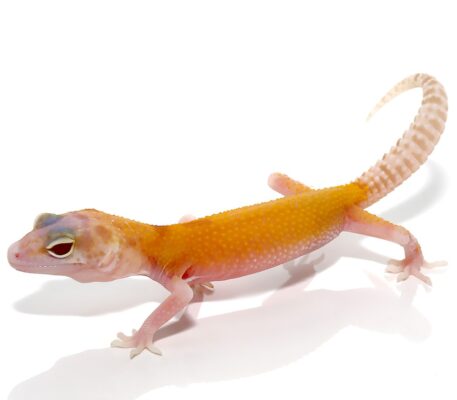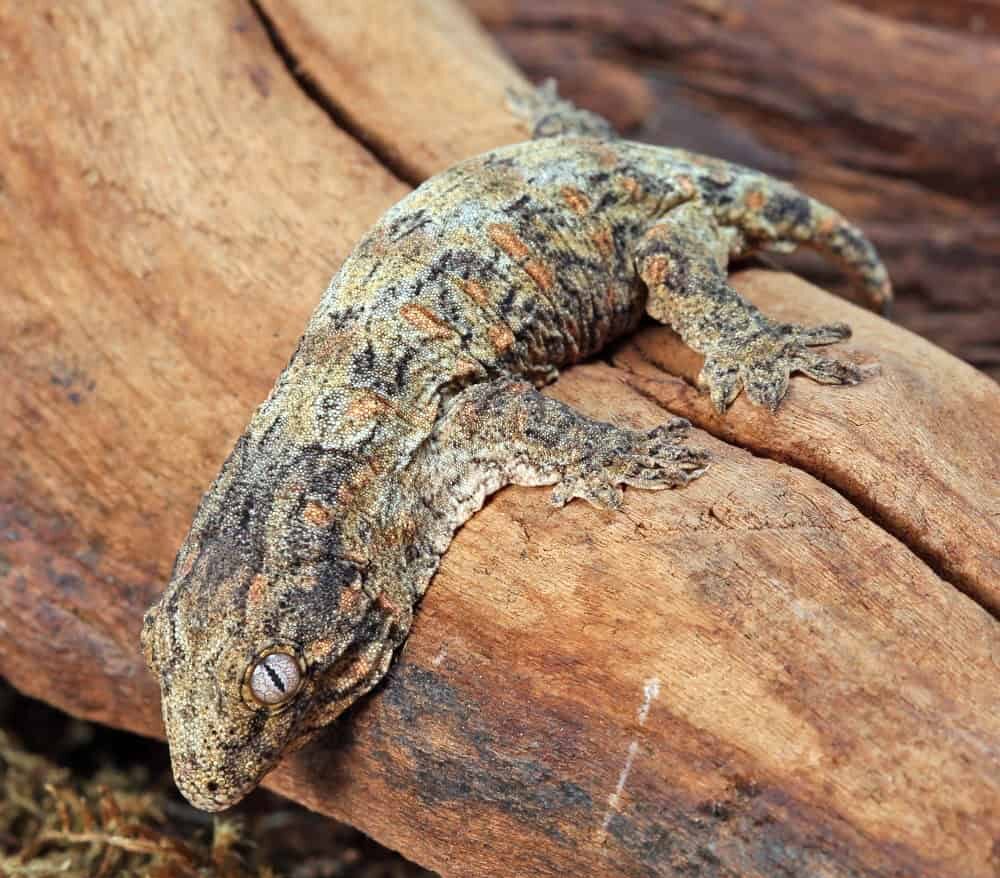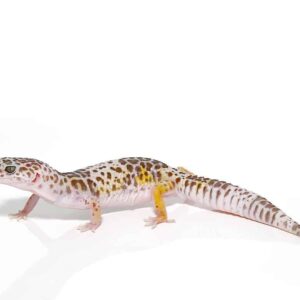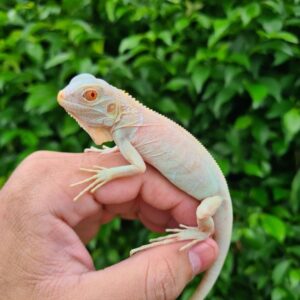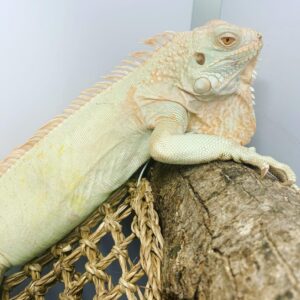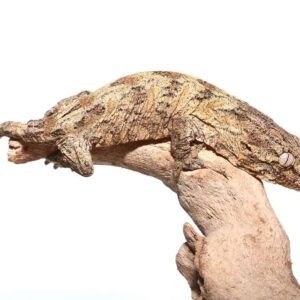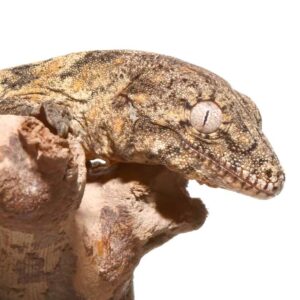Tangerine RADAR Leopard Gecko For Sale
$99.99
WE HAVE JUVENILE TANGERINE RADAR LEOPARD GECKO FOR SALE. HERE ARE SOME HIGHLIGHTS:
- Eublepharis macularius
- Captive Bred
- Roughly 10 – 15 Grams In Weight
- Approximately 4 – 5 Inches In Length From Head To Tail
- Adults Can Reach Up To 8-10 Inches In Length From Head To Tail
- Feeding On Calcium Dusted Crickets & Mealworms
| Options | Single, 3 Pack, Single With Regenerated Tail |
|---|
Description
Juvenile Tangerine Radar Leopard Geckos are a captivating and unique morph of the common leopard gecko, known for their vibrant coloration and distinct genetic traits. Originating from the arid regions of Afghanistan, Pakistan, and parts of India, leopard geckos have been bred selectively over generations to produce a variety of stunning morphs, with the Tangerine Radar being one of the most sought-after among reptile enthusiasts.
Characterized by their striking tangerine hue, juvenile Tangerine Radar Leopard Geckos stand out with their vivid, orange-toned bodies and contrasting lavender or white tails. Their eyes, a defining feature, exhibit a mesmerizing red coloration due to the Eclipse gene, which also contributes to the unique patternless or spotted appearance on their skin. These geckos, with their distinct radar-like eyes, are not only visually appealing but also demonstrate the fascinating outcomes of selective breeding practices.
The popularity of juvenile Tangerine Radar Leopard Geckos among hobbyists can be attributed to their manageable size, docile nature, and relatively simple care requirements. Unlike some other exotic reptiles, they are generally hardy and resilient, making them an excellent choice for both novice and experienced keepers. Additionally, their nocturnal behavior means they are most active during the evening and night, providing ample opportunity for observation and interaction.
Genetically, the Tangerine Radar morph is a combination of several recessive and line-bred traits. The Tangerine aspect is derived from selective breeding for enhanced orange pigmentation, while the Radar trait is a result of combining the Bell Albino and Eclipse genes. This genetic complexity not only makes them a fascinating subject for breeders but also contributes to their allure as a unique and cherished pet.
In summary, juvenile Tangerine Radar Leopard Geckos are a remarkable morph that captivates reptile enthusiasts with their vivid appearance and intriguing genetic makeup. Their ease of care and engaging behavior further solidify their status as a beloved choice in the world of reptile keeping.
Setting Up the Perfect Habitat
Creating an optimal living environment for a juvenile tangerine radar leopard gecko is essential for its health and well-being. The first step in setting up their habitat is selecting an appropriately sized tank. For a juvenile gecko, a 10 to 20-gallon tank is recommended, providing ample space for movement and growth. As they mature, you may consider upgrading to a larger tank to accommodate their increasing size and activity levels.
Choosing the right substrate is crucial for maintaining a clean and safe environment. Reptile carpet, paper towels, or tiles are excellent substrate options for juvenile geckos, as they reduce the risk of impaction—a common health issue caused by ingesting loose substrates like sand or wood chips. Ensure that the substrate is easy to clean and replace to maintain hygiene.
Temperature regulation is another critical aspect of habitat setup. Leopard geckos are ectothermic, meaning they rely on external sources to regulate their body temperature. A temperature gradient within the tank is necessary, with a warm side ranging between 88-92°F (31-33°C) and a cooler side around 75-80°F (24-27°C). This can be achieved using an under-tank heating pad paired with a thermostat. Avoid using heat lamps, as they can cause overheating and stress to your gecko.
Humidity levels should be maintained between 30-40%, replicating the arid environments these geckos naturally inhabit. A hygrometer can help monitor humidity levels, and misting the tank lightly every few days can provide necessary moisture without causing excessive dampness.
Essential accessories for the tank include hideouts, plants, and climbing structures. Hideouts offer your gecko a sense of security and a place to retreat, which is vital for their mental well-being. Placing one hideout on the warm side and another on the cool side of the tank ensures your gecko can regulate its temperature comfortably. Adding artificial plants and climbing structures not only enhances the aesthetic of the habitat but also stimulates natural behaviors and provides physical exercise.
By carefully considering these elements, you can create a thriving environment for your juvenile tangerine radar leopard gecko, promoting its health and happiness as it grows.
Diet and Nutrition
Ensuring the proper diet and nutrition of juvenile tangerine radar leopard geckos is crucial for their health and development. These geckos primarily thrive on a diet of live insects, with particular emphasis on crickets, mealworms, and dubia roaches. These insects should be gut-loaded before feeding, which involves feeding the insects a nutritious diet to enhance their nutritional value when consumed by the gecko.
Supplementation is equally important to prevent deficiencies and promote healthy growth. Calcium is essential for bone development and should be provided through a calcium powder that can be dusted onto the insects before feeding. Vitamin D3 is another vital supplement, aiding in calcium absorption. However, it is important to balance the intake of vitamin D3 to avoid hypervitaminosis, which can be harmful. Many reptile owners opt for a combined calcium and vitamin D3 supplement to simplify the process.
Feeding schedules for juvenile tangerine radar leopard geckos should be consistent to maintain their health. Generally, young geckos should be fed daily due to their rapid growth and higher metabolic needs. As they mature, the frequency can be adjusted to every other day. Monitoring the gecko’s weight and overall health can help in fine-tuning the feeding schedule and ensuring they are not over or underfed.
To ensure a balanced diet, variety is key. Offering different types of insects can prevent nutritional deficiencies and keep the gecko engaged during feeding. Additionally, occasional treats such as waxworms can be given, but these should not form the bulk of their diet due to their high-fat content.
Lastly, fresh water should always be available. Juvenile tangerine radar leopard geckos may not drink large amounts, but it is crucial to provide a shallow dish of clean water at all times. Regularly checking and refreshing the water ensures it remains free of debris and contaminants.
Health and Wellness
Ensuring the health and wellness of your juvenile Tangerine Radar Leopard Gecko is paramount to their overall well-being and longevity. Regular health check-ups are crucial. Begin by observing your gecko’s behavior and physical appearance daily. Healthy geckos are active, have clear eyes, and exhibit a smooth and vibrant skin texture. Any signs of lethargy, weight loss, or changes in their skin and eyes should be promptly investigated. Common health issues include metabolic bone disease, respiratory infections, and parasitic infestations. Early detection and intervention are key in addressing these problems effectively.
Maintaining hygiene in their habitat is another critical aspect. Clean the enclosure regularly to prevent the buildup of harmful bacteria and fungi. This includes spot-cleaning daily and conducting a more thorough cleaning weekly. Replace substrate as needed and ensure that water dishes are clean and filled with fresh water. Good hygiene practices significantly reduce the risk of infections and health complications.
UVB lighting plays a vital role in the health of your juvenile Tangerine Radar Leopard Gecko. While Leopard Geckos are nocturnal and do not require as much UVB exposure as diurnal reptiles, providing a low-level UVB light can aid in calcium absorption, thereby preventing metabolic bone disease. This condition is caused by a deficiency in calcium and vitamin D3, leading to weak and deformed bones. Supplementing their diet with calcium and vitamin D3 is essential. Dust their food with a calcium supplement at every feeding, and provide a multivitamin supplement weekly to ensure they receive a balanced intake of nutrients.
By adhering to these health and wellness guidelines, you can help your juvenile Tangerine Radar Leopard Gecko thrive in a safe and nurturing environment. Regular monitoring, maintaining a clean habitat, and ensuring proper nutrition and UVB exposure are fundamental in promoting their overall health and preventing common ailments.
Behavior and Temperament
Juvenile tangerine radar leopard geckos exhibit a unique set of behaviors and temperaments that differentiate them from other reptiles. Understanding these characteristics is crucial for fostering a healthy and stress-free environment for your pet. Generally, these geckos are nocturnal, meaning they are most active during the evening and night hours. You may notice your gecko spending the daytime resting or hiding, which is normal and should not be a cause for concern.
In terms of temperament, juvenile tangerine radar leopard geckos are known for their docile and gentle nature. They are typically more timid compared to adult geckos, and it is essential to approach them with patience and care. When handling your gecko, make sure to do so gently and support their body fully. Sudden movements or rough handling can stress them out, potentially leading to defensive behaviors such as tail-dropping. Building trust with your gecko can be a gradual process, involving consistent, gentle interactions.
To reduce stress and make your gecko feel secure, it is vital to provide a well-structured habitat. This includes hiding spots, proper temperature gradients, and regular cleaning. Additionally, observe your gecko for signs of stress such as excessive hiding, refusal to eat, or erratic movements. If these behaviors persist, reassess their environment and handling practices to ensure they align with the specific needs of a juvenile tangerine radar leopard gecko.
By paying close attention to their behavior and temperament, you can create a nurturing environment that supports the well-being of your juvenile tangerine radar leopard gecko. This will not only enhance their quality of life but also strengthen the bond between you and your pet, leading to a mutually rewarding experience.
Breeding and Genetics
Breeding tangerine radar leopard geckos requires a thorough understanding of their genetic traits and careful preparation to ensure the health and well-being of both the geckos and their offspring. The tangerine radar morph is a combination of several genetic traits, including the vibrant tangerine coloration and the radar trait, which is a combination of the Eclipse (solid black eyes) and the Bell Albino traits. Understanding these genetic influences is crucial for any breeder aiming to produce high-quality offspring.
Before embarking on the breeding process, it is essential to ensure that both the male and female geckos are healthy, of appropriate age, and weight. Typically, leopard geckos should be at least a year old and weigh around 50 grams before they are considered ready for breeding. It is also advisable to have a thorough veterinary checkup to rule out any health issues.
The breeding season for leopard geckos generally begins in the spring and can last several months. During this time, it is important to provide an optimal environment for breeding, which includes maintaining a temperature gradient of 78-90°F and ensuring sufficient hiding spots and a nutritious diet rich in calcium and vitamins.
Once a female gecko becomes gravid, or pregnant, she will require extra care. Gravid females should have access to a moist laying box filled with a substrate like vermiculite or sphagnum moss, which will help in egg laying. It is essential to monitor the female’s health closely during this time, as gravid geckos have increased nutritional needs and may become stressed easily.
Egg incubation is another critical aspect of breeding. After the eggs are laid, they should be carefully transferred to an incubator set to a temperature range of 80-90°F, depending on the desired sex of the hatchlings. It is important to maintain a consistent humidity level of around 80% to ensure proper development of the eggs. With diligent care and attention, the eggs will typically hatch within 45-60 days, bringing new life into the world of tangerine radar leopard geckos.
Common Mistakes and How to Avoid Them
When caring for juvenile tangerine radar leopard geckos, new owners often make several common mistakes that can affect the well-being of these vibrant reptiles. Understanding and avoiding these pitfalls is crucial for ensuring a healthy and thriving pet.
One frequent error is improper habitat setup. Juvenile tangerine radar leopard geckos require a well-structured environment that mimics their natural habitat. Ensure the enclosure maintains the correct temperature gradient, with a warm side of around 90°F and a cooler side of 75°F. Additionally, avoid using loose substrates like sand, which can cause impaction if ingested. Opt for reptile carpet, paper towels, or tile as safer alternatives.
Dietary mistakes are another common issue. Juvenile geckos need a diet rich in appropriately sized insects such as crickets and mealworms. Overfeeding or underfeeding can lead to health problems. Feed them every day or every other day, and always dust the insects with a calcium supplement to prevent metabolic bone disease. Avoid feeding wild-caught insects, as they may carry parasites or pesticides harmful to your gecko.
Handling juvenile tangerine radar leopard geckos requires care and patience. New owners should understand that these geckos can be stressed easily, especially when they are young. Limit handling sessions to short durations and ensure the gecko feels secure. Avoid sudden movements and support their entire body to prevent injury or stress.
Recognizing health issues early is vital. New owners should be vigilant for signs of illness such as lethargy, loss of appetite, unusual feces, or visible parasites. Regularly check your gecko for any physical abnormalities like skin issues or retained sheds. Establishing a relationship with a reptile-savvy veterinarian can provide valuable support and guidance in maintaining your gecko’s health.
By addressing these common mistakes and implementing the right care practices, new owners can provide a nurturing environment for their juvenile tangerine radar leopard geckos, ensuring a happy and healthy life for their colorful companions.
Resources and Further Reading
For those dedicated to the well-being of their juvenile Tangerine Radar Leopard Geckos, a plethora of resources is available to support your ongoing learning and care efforts. Engaging with these materials will not only enhance your knowledge but also connect you with a community of fellow gecko enthusiasts.
One of the foundational texts for gecko owners is “The Leopard Gecko Manual” by Philippe de Vosjoli et al. This comprehensive guide covers everything from basic care to advanced breeding techniques, making it an invaluable resource for both novice and experienced owners alike. Another highly recommended book is “Leopard Geckos for Dummies” by Liz Palika, which provides easy-to-understand information and practical tips.
In addition to books, numerous websites offer extensive information on Leopard Gecko care. Gecko Time (www.geckotime.com) is a well-regarded site featuring articles written by experts in the field. Similarly, The Leopard Gecko Wiki (www.leopardgeckowiki.com) serves as a comprehensive database of knowledge, covering a wide range of topics including health, diet, and habitat setup.
Forums and online communities can also be incredibly valuable for gecko owners seeking advice and sharing experiences. Websites like Geckos Unlimited (www.geckosunlimited.com) and The Reptile Forum (www.reptileforums.co.uk) provide platforms for discussion, where members can ask questions, share stories, and offer support. These forums often have specific sections dedicated to Leopard Geckos, ensuring that the information is relevant and targeted.
For those interested in local connections, joining a reptile club can be a rewarding experience. Clubs like the International Herpetological Society (IHS) and local herpetological societies often host meetings, events, and expos where members can learn from each other and even exchange or purchase geckos and supplies. These gatherings are excellent opportunities to meet fellow enthusiasts and deepen your understanding of herpetology.
By utilizing these resources, you can ensure that your juvenile Tangerine Radar Leopard Gecko receives the best possible care and thrive in its environment. The ongoing journey of learning and community engagement will undoubtedly enrich your experience as a gecko owner.
